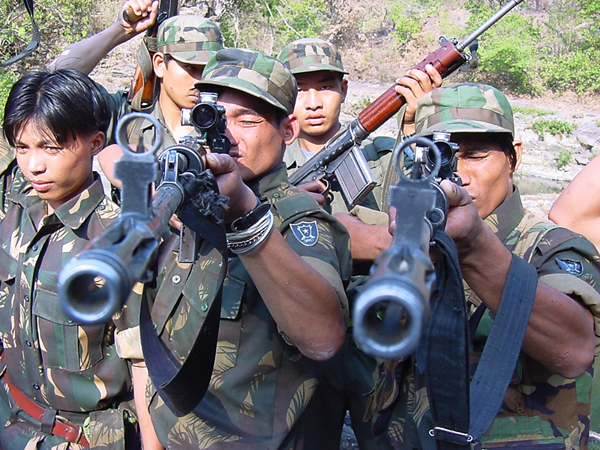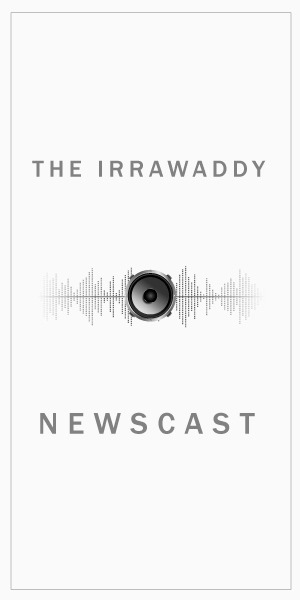Indian Prime Minster Narendra Modi’s virtual speech at the UN General Assembly last month touched upon a wide range of issues, some of which are relevant to India’s northeast and its neighborhood. A number of those topics are sure to have been among the “important bilateral issues” that, according to the Indian Embassy in Yangon, were discussed when Indian army chief General MM Naravane, Foreign Secretary Harsh Vardhan Shringla and Ambassador Shri Saurabh Kumar met with State Counselor Daw Aung San Suu Kyi at the Ministry of Foreign Affairs in Naypyityaw on Monday.
The Indian foreign secretary and army chief presented Daw Aung San Suu Kyi with over 3,000 vials of Remdesivir, a drug used to treat COVID-19 patients, according to the embassy. The Indian delegation also held meetings with Myanmar military chief Senior General Min Aung Hlaing and his deputy, Vice Senior General Soe Win, in the capital.
“From India’s Neighborhood First policy to our Act East policy, as well as the idea of security and growth for all in the region, or our views towards the Indo-Pacific region, we have always worked for the interests of humankind, and not driven by our own self-interests. India’s partnerships are always guided by this very principle,” Prime Minister Modi told the UN.
Modi also underlined New Delhi’s commitment to fighting terrorism and the smuggling of illegal weapons and drugs. Needless to say, India’s northeast and neighboring Myanmar have long been afflicted with the twin problems of insurgency and drug trafficking.
The northeast is also the gateway to Southeast Asia, and peace and economic development in this region are keys to the success of the Act East policy, aimed at strengthening India’s ties with the Asia-Pacific region.
Much of the peace building efforts would depend on whether India can really convince Myanmar to flush out the northeastern rebels operating from its soil. India and Myanmar share a porous, 1,643-km boundary that facilitates cross-border movement of militants, illegal weapons, drugs, gold and precious stones, among other things.
Illegal weapons
On Sept. 28, India’s Border Security Force (BSF) confiscated a large cache of weapons, including 29 AK-series rifles and 7,894 assorted pieces of ammunition, among other items, from two vehicles in Mizoram State’s Mamit district, near the India-Bangladesh border. Three persons were arrested in this connection.
While details of the investigation are still awaited, the choice of this route reveals a new modus operandi among suppliers, as Mizoram is the most peaceful state in the region. The state formally bade adieu to insurgency following the signing of the 1986 Mizo Peace Accord, the country’s only successful peace agreement since India became independent in 1947.
In Myanmar, which is home to scores of rebel outfits, the menace of weapons smuggling from China is posing new challenges to government agencies. Recently, a consignment of 500 Chinese assault rifles, 30 universal machine guns, 70,000 rounds of ammunition and a huge cache of grenades were supplied to the Arakan Army (AA), which is fighting the Myanmar state, The Economic Times reported, quoting security experts.

The AA and the Arakan Rohingya Salvation Army (ARSA), which are active in Rakhine State bordering Bangladesh, are designated as terrorist organizations.
Earlier in June, Thai officials seized a large cache of Chinese-made weapons, including M16, M79, M5.56 and AK-47 automatic rifles and machine guns, and arrested two persons, in Tak province’s Mae Sot district, The Irrawaddy reported.
According to the report, Rakhine militants as well as Indian insurgents with training camps in Myanmar’s Sagaing region are the main buyers of illegal arms.
Guwahati-based journalist and author Rajeev Bhattacharyya, who has written extensively on northeastern insurgencies, said the India-Myanmar border became a hotspot for small arms proliferation in the late 1990s.
“This was the period when insurgency was at its peak in the northeast. And so, the demand was from these outfits. There were also intermittent reports of weapons from the northeast reaching rebel groups in other parts of India,” said Bhattacharyya, who has written a book, “Rendezvous with Rebels: Journey to meet India’s Most Wanted Men”, based on his visit to rebel camps in Myanmar.
“The sources of these weapons were the gray markets in China and Southeast Asia, which sold a wide range of arms and ammunitions ranging from AK-series rifles and American M16s to grenades and pistols,” he added.
Bhattacharyya said the demand for weapons has come down drastically in the northeast in the past six to seven years after an “overwhelming majority of rebel groups entered into ceasefire pacts with the government of India in the hope of a negotiated settlement of their demands”.
Drug smuggling
India’s Mizoram state, which shares over 500 km of unfenced border with Myanmar, has emerged as a major drug trafficking route in the past few years. Yaba tablets and other synthetic drugs are regularly smuggled into the northeast from Myanmar and then pushed to other Indian states, besides Bangladesh and Sri Lanka.
Earlier this year, nongovernment organizations (NGOs) in Mizoram demanded fencing along the India-Myanmar border, citing drug seizures worth 10 million Indian rupees (US$136,526, or 177.76 million kyats) in February-March alone.
Experts say that towards the end of the last century, drug cartels in the Golden Triangle—the area where the borders of Myanmar, Thailand and Laos meet—switched to the production of methamphetamine or meth, turning it into a more lucrative trade than heroin. The popularity of meth soared in Thailand, where it is known as “yaba”, or “crazy drug”. In Bangladesh, the name yaba has metamorphosed into “baba”.
Myanmar’s Shan State is the biggest producer of yaba tablets. There were reports that makeshift factories produce over 1 billion yaba pills annually in that region, from where they are smuggled to other Asian countries, Europe and the Americas.
Alarmingly, India reported a substantial increase in seizures of amphetamine-type stimulants (ATS), up from 431 kg in 2018 to more than 2.2 tons in 2019, according to a report from the United Nations Office on Drugs and Crime. “This could, at least partially, be the consequence of the emergence of a new trafficking route from Myanmar through India’s border for trafficking to Bangladesh,” it said.
New Delhi and Naypyitaw signed a memorandum of understanding in 2014 to check illegal cross-border activities, but nothing much has been achieved in the past six years. The onus is definitely on India to convince its eastern neighbor to act against the menace of drug trafficking and arms smuggling, two major hurdles before its Act East policy.
Jayanta Kalita is a senior journalist and author based in New Delhi. He writes on issues relating to India’s northeast and its immediate neighborhood. His views are his own.
You may also like these stories:
Bangladesh Restarts Some Factories; India Debates Easing Restrictions.
Bangladesh Says it Won’t Assimilate Rohingya Muslims
‘Vocabulary Crisis’ Creates Yet Another Hurdle for Myanmar’s Federalism

















